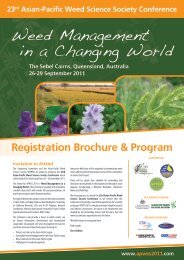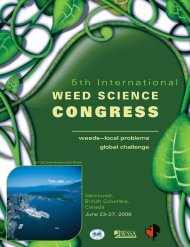PARAQUAT
PARAQUAT
PARAQUAT
Create successful ePaper yourself
Turn your PDF publications into a flip-book with our unique Google optimized e-Paper software.
• Dole Food Company announced in October<br />
2007 that it was discontinuing the use of paraquat<br />
worldwide in its operations (Dole 2008).<br />
• Chiquita has also stopped using paraquat in<br />
banana plantations (Gochez 2009).<br />
• United Plantations has announced it will<br />
cease use of paraquat on all its plantations<br />
by January 1st, 2011 (UP 2010). United<br />
Plantations is one of the largest oil palm<br />
plantation companies in Malaysia; it also has<br />
some coconut plantations, and oil palm in<br />
Indonesia.<br />
• The Danish company AarhusKarlshamn,<br />
a leading producer of speciality vegetable<br />
oils and fats and a founding member of the<br />
Roundtable for Sustainable Palm Oil has<br />
stated that paraquat should be minimised<br />
or phased out “as soon as possible” (Frank<br />
2010).<br />
2. Toxicological Assessment<br />
2.1 Absorption and distribution<br />
Paraquat can be rapidly absorbed by inhalation<br />
and through the intestine after ingestion.<br />
Absorption after oral intake is about 10% (EC<br />
2003).<br />
Absorption through intact skin is generally low,<br />
0.5% according to EC (2003), but is substantially<br />
increased if the skin is damaged, and has lead<br />
to death in humans (Kemi 2006).<br />
After oral intake, there is high initial concentration<br />
in the liver and kidneys, which then reduces.<br />
Plasma concentration is relatively stable for 30<br />
hrs, and concentration in the lungs increases.<br />
It is actively concentrated in the lungs (Kemi<br />
2006).<br />
Low levels of paraquat may be retained in<br />
muscle tissue after skin exposure and slowly<br />
released into the blood (Lee 2008a).<br />
Metabolism of paraquat is limited, and it is largely<br />
(69-96%) excreted in the faeces unchanged. One<br />
study showed a degree of microbial degradation<br />
in the gut (US EPA 1997).<br />
2.2 Acute toxicity<br />
WHO (2010) Recommended Classification of<br />
Pesticides by Hazard: Class II Moderately toxic.<br />
However, it is argued that paraquat, because of<br />
its acute toxicity, delayed effects, and absence<br />
of an antidote should be in WHO Class 1a or 1b<br />
(Isenring 2006).<br />
US EPA (1997) Hazard Classifi cation:<br />
• Acute toxicity by inhalation = Category I,<br />
highly toxic<br />
• Acute toxicity from oral intake = Category II,<br />
moderately toxic<br />
• Systemic toxicity from dermal absorption =<br />
Category III, slightly toxic<br />
• Eye irritation = Category II, moderate to<br />
severe<br />
• Skin irritation = Category IV, minimal<br />
Lethal doses<br />
The lethal dose, LD 50 , is the dose that kills 50%<br />
of test animals.<br />
A wide variety of lethal doses have been<br />
reported, some expressed in terms of paraquat<br />
ion and some technical grade paraquat<br />
dichloride, others not identifying which but<br />
presumed to be in terms of paraquat ion.<br />
Oral:<br />
FAO (2008):<br />
• Oral LD 50 rat, male = 113.5 mg/kg body<br />
weight (paraquat ion), which is 344 (range<br />
246-457) mg/kg bw of paraquat dichloride<br />
technical<br />
• Oral LD 50 rat, female = 93.4 mg/kg bw<br />
(paraquat ion), 40-200 mg/kg bw of paraquat<br />
dichloride technical<br />
Kemi (2006):<br />
• Oral LD 50 rat = 40-200 mg/kg<br />
• Oral LD 50 mouse = 120 mg/kg<br />
• Oral LD 50 guinea pig = 22-80 mg/kg<br />
• Oral LD 50 rabbit = 49-150 mg/kg<br />
• Oral LD 50 sheep = 50-75 mg/kg<br />
• Oral LD 50 cat = 26-50 mg/kg<br />
• Oral LD 50 dog = 25-50 mg/kg<br />
• Oral LD 50 monkey = 50 mg/kg<br />
• Oral LD 50 human = 40-60 mg/kg<br />
9




